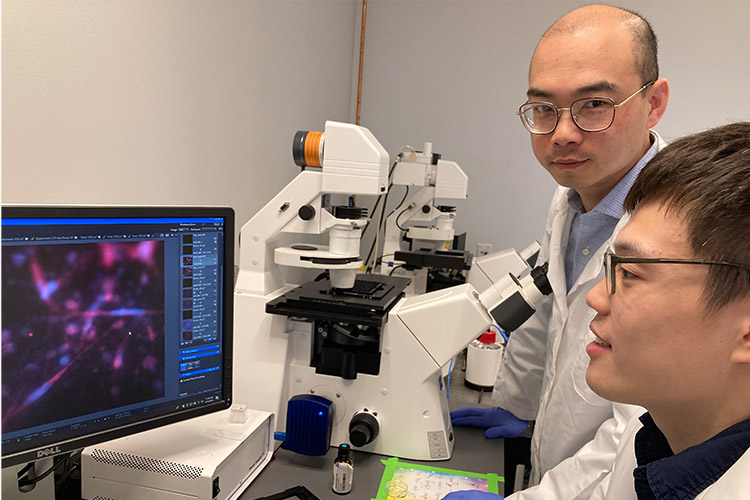
Qingsu Cheng (left), assistant professor of biomedical engineering at UWM, examines magnified images of fibroblast cells with post-doctoral researcher Michael Weizheng Wang. Cheng has received funding to investigate the interactions of fibroblasts with breast cancer cells during radiation treatment. (UWM Photo/Laura Otto)
Why does breast cancer sometimes come back, even after what seems like successful treatment and periods of being cancer-free? A researcher at UW-Milwaukee is investigating the fact that some cancer cells go dormant to hide from radiation treatment – only to wake up later and return, sometimes even stronger.
Between 40% to 50% of breast cancers return after a period of remission. One reason may be that certain cancer cells survive treatment by slipping into a dormant state. These “sleeping” cells aren’t actively growing or dividing, which makes them harder for radiation and chemotherapy to detect and destroy.
Qingsu Cheng, assistant professor of biomedical engineering, believes a certain kind of cell called a fibroblast might be helping cancer cells enter and later emerge from this hidden state.
Cheng will dig deeper into whether fibroblasts facilitate the cancer cells’ work-around during radiation exposure with funding from the Shaw Scientist Award from the Greater Milwaukee Foundation.
The annual award supports research in biochemistry, biological sciences, and cancer research by providing $200,000 in funding to early career scientists at UW-Madison and UW-Milwaukee. The fund was established by the late James D. and Dorothy Shaw, donors to the Greater Milwaukee Foundation.
Cancer’s effect on fibroblasts
Fibroblasts are usually part of the body’s healing system. But in cancer, tumors can hijack fibroblasts, reprogramming them from defenders into promoters that help cancer grow, spread and resist treatment.
“We know some parts of the story, but not all of it,” Cheng said. “If we can stop cancer cells from going dormant in the first place, we might reduce the chance of the cancer coming back after successful treatment.”
Radiation is a powerful tool in the fight against cancer because it can reach deep into tissues and destroy cancer cells. But some cells survive. Cheng wants to know: What exactly happens at the cellular level when radiation penetrates the tumor’s microenvironment? And are fibroblasts somehow being recruited to help in the process of dormancy?
Other factors
His lab will also explore what revives these hidden cells and how the body’s circulatory system may be involved in helping cancer cells spread or resist treatment during radiation exposure.
If radiation plays a role in these processes, then a logical related question for Cheng is: Does a patient’s lifetime exposure to low-dose radiation — like from medical scans or mining work – fit into the puzzle?
Some people are more susceptible to the radiation than others, but little is known about why. Findings of this project could provide clues.
The project also will look at high-density breast tissue, which tends to contain more reprogrammed fibroblasts and is a known risk factor for developing breast cancer. It may also play a role in why some cancers return after treatment.
“By understanding the microenvironment around tumors, we can start to identify new targets for treatment,” Cheng said. Once those targets are known, he plans to test potential drugs or therapies to stop cancer from hiding.
Written by Laura Otto
Link to original story: https://uwm.edu/news/uwm-researcher-receives-shaw-award-to-study-why-some-breast-cancer-cells-survive-radiation-2/
